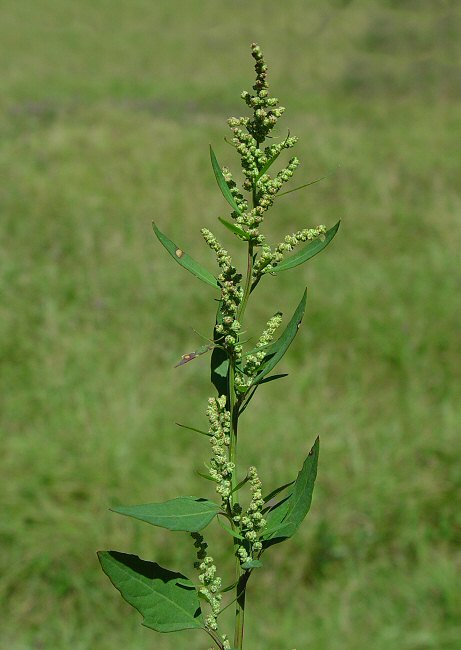Chenopodium album L.
Pigweed

Introduced
CC = *
CW = 3
MOC = 81
© DETenaglia
Chenopodium album L.Pigweed | |
 |
Introduced CC = * CW = 3 MOC = 81 |
© DETenaglia |
|
Family - Chenopodiaceae Habit - Annual forb, lacking in strong odor. Stems - Ascending to erect, to 1.5 m, usually branched above the base, glabrous or more commonly sparsely to moderately white-mealy, sometimes reddish-tinged or reddish purple-striped, but usually lacking a pronounced reddish purple area at the base of each leaf.
Leaves - Simple, mostly long-petiolate. Leaf blades 1-6 cm long, 1-4 cm wide, often more than 1.5 times as long as wide in the largest (lowermost) leaves, rhombic to ovate-rhombic, grading to linear to narrowly lanceolate in the uppermost leaves, angled or tapered to a bluntly or sharply pointed tip, the middle lobe not appearing unusually elongate, angled at the base, green or reddish-tinged, thin and herbaceous to thickened, somewhat leathery, and slightly succulent in texture, the margins entire to wavy or irregularly several-toothed (the basal pair of teeth usually larger than the others, sometimes appearing shallowly lobed), the upper surface glabrous or sparsely to moderately mealy at maturity, not shiny, the undersurface moderately to more commonly densely white-mealy. Venation noticeably branched, with 1 or 3 main veins.
Inflorescence - Short spikes with small clusters of flowers, both axillary and terminal, the terminal ones usually grouped into small to relatively large panicles. Flowers not all maturing at the same time.
Flowers - Perfect. Calyx 5-lobed nearly to the base, the lobes 0.7-1.2 mm long, ovate to triangular-ovate, bluntly pointed, usually broadly keeled, persistent at fruiting and entirely enclosing the fruit, moderately to densely white-mealy. Stamens 5. Ovary superior. Styles 2. Stigmas 2.
Fruits - 1.2-1.5 mm wide, depressed-ovoid, the seeds positioned horizontally, the wall thin, membranous, and somewhat translucent, smooth or finely roughened, not appearing honeycombed, usually difficult to separate from the seed. Seeds black, shiny, smooth or nearly so, rounded to very bluntly angled along the rim.
Flowering - May - October. Habitat - Crop fields, streambanks, roadsides, railroads. Origin - Probably native to Eurasia, possibly U.S. Lookalikes - Numerous species of Chenopodium and Amaranthus. As a group these often require detailed microscopic examination for a reliable ID, and even then may be difficult to identify to species. Other info. - This species can be found throughout Missouri and the continental U.S., and is a common weed of crop fields and disturbed areas. It is the most common member of the genus in Missouri, and probably one of the most widely distributed angiosperms on the planet. The plant can often be recognized at quite a distance by the whitish underside of the leaves. In the fall the leaves turn a nice crimson color. Photographs taken off Lee Rd. 14, Lochapoka, AL., 9-22-04 (DETenaglia); also at Klondike County Park, St. Charles County, MO, 5-25-2020, and near Labadie, Franklin County, MO, 9-27-2020 (SRTurner). |